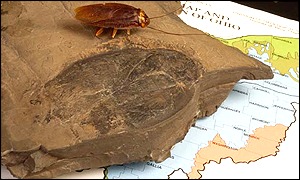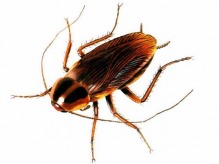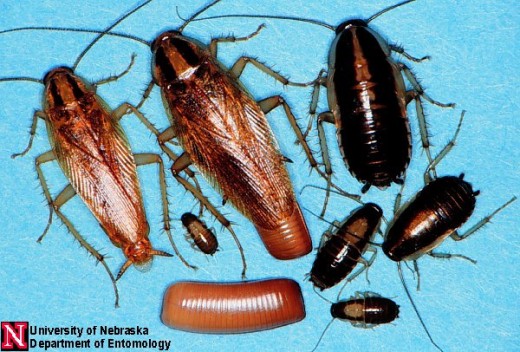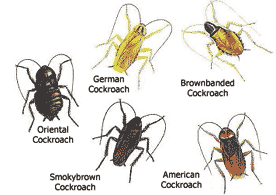The Cockroach - Dealing with Cockroaches

Cockroach History
The earliest fossilised cockroach was found by geologists from Ohio State University in 2001. Measuring 8cms long, it was carbon-dated and proved to belong to the planet 300 million years ago, 55 million years before the first dinosaur.
The really remarkable thing about this discovery was that the cockroach remains unchanged in comparison to its descendants of today’s world. While practically all other life forms on Earth have evolved drastically, the cockroach hasn’t.
If we can overcome our innate distaste for the cockroach, we can learn that is actually an amazing creature.
Virtually unchanged for hundreds of millions of years, it has a unique ability to stay alive. Reckoned to be one of the few species in the world to survive a nuclear war, their ability to adapt and resist chemical controls is notorious. Scientists continually need to develop new pest control chemical formulas as the cockroach ups its resistance level.
The Cockroach and Water
Cut the head off a cockroach, and it can live for up to a week afterwards, only dying when it dehydrates through lack of fluid. Try to drown it by flushing it down the drain is a waste of time. Cockroaches can not only swim, they can hold their breath underwater for up to 40 minutes, plenty of time to traverse the pipes in which it has been placed and come safely out somewhere.
Infestation of Cockroaches
Cockroaches can live for up to a month with food, but only a week without water.
If you have an infestation of cockroaches in your house, get a plumber in to fix all leaks under the sink or under the bath, and never leave exposed water lying around. Your cockroaches should be gone in a week or two if you can ensure they are completely starved of water. This method of cockroach eradication is not recommended, however, as you would really have to drain all your cisterns, and water overflows and not allow them to refill if you wanted to be 100% sure your cockroaches didn’t have anything to drink.
The Cockroach

Cockroach Infestation
Cockroaches are Prolific Breeders
Cockroaches have the ability to hide themselves completely in a house, only coming out to feed after dark, and you are unlikely to know you have a problem until there are too many of them to fit into the tiny hiding places they find.
They are prolific breeders. One pair of cockroaches can turn into 2 million in the space of just 1 year. Some female cockroaches after mating for the first time are pregnant for the rest of their lives! This is because she carries the eggs on the outside of her body and can release those egg casings up to 8 times a year after only being inseminated once. Cockroaches generally only live for one year, but under laboratory conditions can survive up to 4 years.

Cockroach Babies
Eggs and Egg Casings
Each egg casing can contains up to 40 eggs, and when hatched the babies take only 3 – 4 months to reach adulthood where they are big enough to mate themselves.
The hard outer shell of the cockroach gets discarded now and then, leaving a white cockroach though it does change back to its normal color within a few hours. This process is known as molting, and occurs more often in juvenile cockroaches where it happens perhaps once a week.
The Cockroach and a Nuclear Attack
Cockroach Molting
It is at this time of cell division that cockroaches are at their most vulnerable from nuclear attack. Creatures who self-repair or grow through cell division (humans for example) are most at risk from nuclear fallout. As the physiology of cockroaches only uses cell division during their molting process, only those cockroaches actually molting at the time of a burst of radiation are at risk. The rest WILL survive, so cockroaches can survive an atomic bomb.
While cockroaches prefer heat, they can survive temperatures as low as the freezing point of water, although they do tend to get killed off by temperatures lower than this. It is reckoned that they can actually acclimatise to live in colder temperatures as they must have done to survive the previous Ice Ages on planet earth.
The Cockroach Spreads Diseases
Spread Diseases
Cockroaches are considered pests because they spread disease, as well as causing asthma and allergies in some people. Like the mouse, they cast their droppings as they walk, and they eat any organic waste material. Living frequently in drains in hot countries, they walk out of a drain or sewer that could contain human faeces and pathogens, and then walk all over any food that is left out contaminating it. They also contaminate every surface over which they walk, and this is not visible to the naked eye. The faeces of cockroach is reported to resemble grains of black pepper.
They frequently regurgitate half digested food and leave it behind and is that practically invisible to the naked eye. As by morning there is no sign of their nocturnal activities, people may start preparing food over worktops that still look shiny clean from the scrubbing they would have had the night before, with a high risk of these pathogens and bacterium contaminating food, causing maybe illnesses including diarrhoea, dysentery, hepatitis, typhoid, leprosy, tuberculosis, E. Coli, salmonella and dermatitis.

Cockroach Species
There are 4000 species of cockroach in the world, but only a few infest our homes and cause problems. They are the German cockroach (Blattella germanica ), the American cockroach (Periplaneta americana ), the Oriental cockroach (Blatta orientalis ) and the Australian cockroach (Periplaneta australasiae ).
Cockroaches can fly. Their wings are diaphanous (see-through). Leaving windows open at night when they are at their most active is another way they can gain entry to your house.
Deter Cockroaches from your Home
- Always cover foodstuffs, especially sugars as they have a sweet tooth, and don’t leave any water lying around.
- Wash and dry dishes the night before so that water is not left lying in the sink.
- Clear up any crumbs or waste foods immediately.
- Repair any leaky taps or pipes as soon as you notice there is a problem.
- Clean down any grease on or near your cooker.
- Don’t leave waste lying around – take your trash out regularly.
- Keep compost bins back from your doors.
- Weatherstrip your home to prevent access.
- Seal off any cracks and crevices.
- Don’t allow trees and bushes to overhang your home, as this could be an access route.






